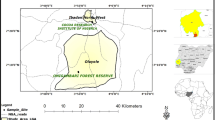Abstract
Total arsenic in four different growth forms of lichens growing on old monuments in the city of Mandav, Dhar district of Madhya Pradesh, India was analyzed. Among the different growth forms, foliose lichens were found to accumulate higher amounts of arsenic followed by leprose form. The squamulose and crustose form accumulates the lower concentration of arsenic and ranged between 0.46 ± 0.03 and 20.99 ± 0.58 μg g − 1 dry weight, while the foliose and leprose lichens have ranges from 10.98–51.95 and 28.63–51.20 μg g − 1 dry weight, respectively. The substrate having high arsenic ranges also exhibit higher ranges of arsenic on lichens growing on them. The cyanolichens exhibit higher concentration of arsenic than the green photobiont-containing squamulose form. The higher concentration of arsenic was found at site having past mining activities. LSD (1%) shows significant difference for As concentration in lichens thallus between the selected sites and species both.
Similar content being viewed by others
References
Al, T. A., & Blowes, D. W. (1999). The hydrogeology of a tailing impoundment formed by central discharge of thickened tailing: implications for tailing management. Journal of Contaminant Hydrology, 38, 489–505. doi:10.1016/S0169-7722(99)00007-8.
Bajpai, R., Upreti, D. K., & Mishra, S. K. (2004). Pollution monitoring with the help of lichen transplant technique (LTT) at some residential sites of Lucknow. Journal of Environmental Biology, 25(2), 191–195.
Brown, D. H., & Beckett, R. P. (1984). Lichens as indicators. Lichenologist (London, England), 16, 173–188. doi:10.1017/S0024282984000323.
Charlesworth, S., Everett, M., McCarty, R., Ordonez, A., & de Miguel, E. A. (2003). A comparative study of heavy metal concentration and distribution in deposited street dust in a large and a small urban area, Birminghman and Coventry, West midlands U. K. Environment International, 29, 563–573. doi:10.1016/S0160-4120(03)00015-1.
Dubey, A. N., Pandey, V., Upreti, D. K., & Singh, J. (1999). Accumulation of lead in lichens growing in and around Faizabad City, U.P. Journal of Environmental Biology, 20(3), 223–225.
Farinha, M. M., Freitas, M. C., & Almeid, S. M. (2004). Air quality control monitoring at an urban and industrilized area. Journal of Radioanalytical and Nuclear Chemistry, 259, 203–207. doi:10.1023/B:JRNC.0000017288.21685.85.
Freitas, M. C., Reis, M. A., alves, L. C., Marques, A. P. & Costa, C. (1999). Environmental assessment in an industrial area of Portugal. Biological Trace Element Research, 71/72, 273–280. doi:10.1007/BF02784213.
Garty, J. (2001). Biomonitoring atmospheric heavy metals with lichens: theory and application. Critical Reviews in Plant Sciences, 20(4), 309–371. doi:10.1016/S0735-2689(01)80040-X.
Goyal, R., & Seaward, M. R. D. (1982). Metal uptake in terricolous lichens. III Translocation in the thallus of Peltigera canina. The New Phytologist, 90, 85–98. doi:10.1111/j.1469-8137.1982.tb03244.x.
Koch, I., Wang, L., Reimer, K. J., & Cullen, W. R. (2000). Arsenic species in terrestrial fungi and lichens from Yellowknife, NWT, Canada. Applied Organometallic Chemistry, 14, 245–252. doi:10.1002/(SICI)1099-0739(200005)14:5<245::AID-AOC986>3.0.CO;2-K.
Loppi, S., & Pirintsos, S. A. (2003). Epiphytic lichens as sentinels for heavy metal pollution at forest ecosystem (central Italy). Environmental Pollution, 121, 327–332. doi:10.1016/S0269-7491(02)00269-5.
Machado, A., Sleykovec, Z., Van Elteran, J. T., Fritas, M. C., & Baptista, M. S. (2006). Arsenic species in transplanted lichens and tree bark in the framework of a biomonitoring scenario. Journal of Atmospheric Chemistry, 53, 237–249. doi:10.1007/s10874-006-9013-2.
Madhavan, N., & Subramanian, V. (2000). Sulphide mining as a source of arsenic in the environment. Current Science, 78, 702–709.
Mishra, S., Srivastava, S., Tripathi, R. D., & Trivedi, P. K. (2008). Thiol metabolism and antioxidant systems complement each other during arsenate detoxification in Ceratophyllum demersum L. Aquatic Toxicology (Amsterdam, Netherlands), 86, 205–215.
Mrak, T., Slejkovec, Z., & Jeran, Z. (2006). Extraction of arsenic compounds from lichens. Talanta, 69, 251–268. doi:10.1016/j.talanta.2005.10.011.
Nayaka, S., Upreti, D. K., Gadgil, M., & Pandey, V. (2003). Distribution pattern and heavy metal accumulation in lichen of Bangalore City with reference to Lalbagh Garden. Current Science, 84(5), 674–680.
Niriagu, J. O., & Azcue, J. M. (1990). Environmental sources of arsenic in food. Advances in Environmental Science and Technology, 23, 103–127.
Rio, M. D., Font, R., Almela, C., Velez, D., Montoro, R., & Bailon, A. D. H. (2002). Heavy metal and arsenic uptake by wild vegetation in the Guadiamar river area after the toxic spill of the Aznalollaor mine. Journal of Biotechnology, 98, 125–137. doi:10.1016/S0168-1656(02)00091-3.
Shukla, V., & Upreti, D. K. (2007). Heavy metal accumulation in Phaeophyscia hispidula en route to Badrinath, Uttaranchal, India. Environmental Monitoring and Assessment, 131, 365–369. doi:10.1007/s10661-006-9481-5.
Singh, N., Ma, L. Q., Srivastava, M., & Rathinasabapthi, B. (2006). Metabolic adaptation to arsenic-induced oxidative stress in Pteris vittata L. and P. ensiformis L. Plant Science, 170, 274–282. doi:10.1016/j.plantsci.2005.08.013.
Sloof, J. E. (1991). Lichens as quantitative biomonitors for atmosphere trace elements deposition, using transplants. Atmospheric Environment, 29, 11–19. doi:10.1016/1352-2310(94)00221-6.
Srivastava, S., Mishra, S., Tripathi, R. D., Dwivedi, S., Trivedi, P. K., & Tandon, P. K. (2007). Phytochelatins and antioxidant systems respond differently during arsenite and arsenate stress in Hydrilla verticillata (L.f) Royle. Environmental Science & Technology, 41, 2930–2936. doi:10.1021/es062167j.
Upreti, D. K., & Pandey, V. (2000). Determination of heavy metals in lichens growing on different ecological habitats in Schirmacher Oasis, East Antarctica. Spectroscopy Letters, 33(3), 435–444. doi:10.1080/00387010009350090.
Author information
Authors and Affiliations
Corresponding author
Rights and permissions
About this article
Cite this article
Bajpai, R., Upreti, D.K. & Dwivedi, S.K. Arsenic accumulation in lichens of Mandav monuments, Dhar district, Madhya Pradesh, India. Environ Monit Assess 159, 437–442 (2009). https://doi.org/10.1007/s10661-008-0641-7
Received:
Accepted:
Published:
Issue Date:
DOI: https://doi.org/10.1007/s10661-008-0641-7




